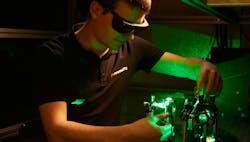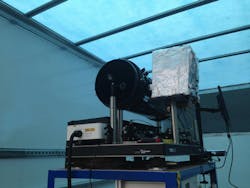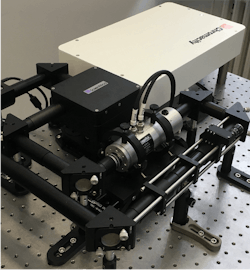Ultrafast lasers drive nonlinear microscopy, environmental sensing, and quantum technologies
Adoption of ultrafast lasers capable of emitting picosecond and femtosecond pulses is growing within many different industries, and its applications include high-value manufacturing, sensing, diagnostics, fundamental research, environmental monitoring, and healthcare.
The expansion into new applications required years of R&D efforts to meet the demands of an ever-changing landscape with diverse process requirements. It pushed the limits of what was achievable for ultrafast lasers—and the result today is much more reliable, compact, energy-efficient systems that are easier to use. This is largely thanks to the evolution of fiber-based ultrafast lasers.
Development of novel, compact, air-cooled fiber lasers was supported by advances in passive modelocking techniques, which generate ultrashort pulses of light. The most widespread techniques are semiconductor saturable absorber mirrors (SESAMs), nonlinear polarization rotation, nonlinear fiber loop mirrors, and carbon nanotube saturable absorbers.
Chromacity’s fixed-wavelength fiber lasers rely on a master oscillator power amplifier (MOPA) architecture to define and manage the balance of power and pulse quality. Our cavity design and nonlinear polarization rotation modelocking technique enables high-quality ultrafast pulses, while maintaining the highest laser slope efficiency (see Fig. 1). The subsequent boost in power from our mode-locked oscillator is beneficial for seeding a single power amplifier stage to the 5–10 W average power level—without the need for an additional preamplifier.
This enables us to take advantage of both free space and a fiber architecture to create ultraefficient and small-form-factor lasers that are easy to integrate into any system.
Nonlinear microscopy
One of the fields enabled by ultrashort femtosecond pulses is nonlinear microscopy, which includes methods such as second-harmonic generation (SHG) microscopy, two-photon fluorescence lifetime imaging microscopy (2P-FLIM), and two-photon excited fluorescence (2PEF) microscopy. These techniques take advantage of low absorption and the scattering of infrared (IR) light to provide increased depth measurement of biological samples. By using femtosecond-pulsed IR laser radiation, they generate shorter wavelength light to image samples.
Nonlinear microscopy was revolutionized by the evolution of compact air-cooled lasers, which made the technique much more accessible. This area was traditionally dominated by titanium sapphire (Ti:Sapphire) lasers due to their tunability (typically between 680 and 1080 nm). But the benefits of compact air-cooled, fixed-wavelength fiber laser systems are driving their rapid adoption across much of this application space. Although Ti:Sapphire lasers are tunable, the benefits of fiber lasers with their smaller footprint, low maintenance, and lower cost of ownership outweigh a lack of tunability.
For fiber lasers to be fully adopted as the go-to laser source for nonlinear microscopy imaging systems, such as 2PEF microscopy, it is critical for the wavelength to overlap with the fluorophore absorption lines. This inspired the development of matching lasers, particularly at 920 nm, 1040 nm, and 780 nm. Chromacity developed a 920-nm femtosecond laser to excite common fluorophores used for 2PEF microscopy and neuroscience imaging.
Environmental sensing
Environmental gas monitoring is a global priority, and it requires a robust and sensitive real-time measurement technique. The ability to measure and assess gas emissions in real-time is critical to improve the environmental footprint within many industries, including gas extraction and processing, industrial facilities, wastewater treatment plants, agriculture, agroforestry, and landfill sites. One possible solution is an open path Fourier transform infrared spectroscopy (FTIR)-based system (see Fig. 2).
An ideal laser source system for such an application must be highly tunable, enable high-resolution spectroscopy, and have good beam quality. These requirements are fulfilled by optical parametric oscillators (OPOs; see Fig. 3). The ability to select the wavelength region of interest within the range of 1.4 to 12 µm offers unprecedented flexibility and can target many absorption lines of interest. The feasibility of using this type of laser for laser spectroscopy applications in long-range gas absorption measurements was successfully demonstrated during a recent project in collaboration with Professor Derryck Reid and his research group from Heriot-Watt University. The system was tuned to target methane and ethane absorption bands and demonstrated the ability to measure gas concentrations at parts-per-billon precision.
Quantum technologies
During the past decade, quantum technologies have seen significant growth. Many of the applications under the quantum technologies umbrella, such as quantum spectroscopy, quantum entanglement, and quantum cryptography, are contributing to shaping the direction of laser development. These applications are underpinned by the ability to reliably create quantum entanglement.
One of the methods to achieve quantum entanglement is spontaneous parametric downconversion (SPDC). This technique typically requires a laser system capable of producing ultrashort pulses, which deliver very high peak powers to the nonlinear crystal vehicle for generating the SPDC. Fixed-wavelength lasers that generate femtosecond pulses are an ideal choice for this application.
Applications such as quantum spectroscopy require more sophisticated laser sources that generate a wide spectrum of IR wavelengths to enable greater flexibility. Ultrashort-pulse durations and mid-IR tunable lasers are an ideal match, and the ability to select wavelength bands stretching from shortwave- to longwave-IR light offers remarkable resilience for the application.
The future
Ultrafast fiber laser technology has matured significantly during the last two decades—allowing most users to take advantage of their ease of use, efficiency, and low cost. With near-term advances in materials science for modelocking, miniaturization of the electronics, and improvements in optical efficiency, ultrafast lasers are poised to become smaller, more efficient, with higher power. This will lead to their adoption by new users for materials processing, nonlinear optics, and quantum applications.
Related Article
About the Author
Wojciech Gora
Wojciech Gora is the product and applications manager for Chromacity Ltd., which is based in Edinburgh, U.K.



